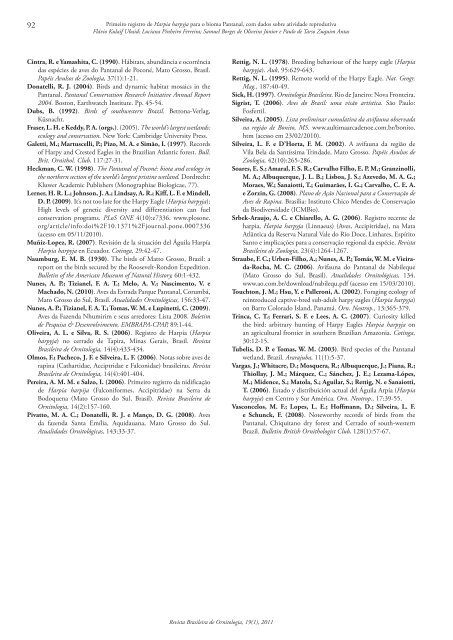Capa 19(1) - fechada.indd - Sociedade Brasileira de Ornitologia
Capa 19(1) - fechada.indd - Sociedade Brasileira de Ornitologia
Capa 19(1) - fechada.indd - Sociedade Brasileira de Ornitologia
You also want an ePaper? Increase the reach of your titles
YUMPU automatically turns print PDFs into web optimized ePapers that Google loves.
92 Primeiro registro <strong>de</strong> Harpia harpyja para o bioma Pantanal, com dados sobre ativida<strong>de</strong> reprodutiva<br />
Flávio Kulaif Ubaid; Luciana Pinheiro Ferreira; Samuel Borges <strong>de</strong> Oliveira Júnior e Paulo <strong>de</strong> Tarso Zuquim Antas<br />
Cintra, R. e Yamashita, C. (<strong>19</strong>90). Hábitats, abundância e ocorrência<br />
das espécies <strong>de</strong> aves do Pantanal <strong>de</strong> Poconé, Mato Grosso, Brasil.<br />
Papéis Avulsos <strong>de</strong> Zoologia, 37(1):1‐21.<br />
Donatelli, R. J. (2004). Birds and dynamic habitat mosaics in the<br />
Pantanal. Pantanal Conservation Research Initiative Annual Report<br />
2004. Boston, Earthwatch Institute. Pp. 45‐54.<br />
Dubs, B. (<strong>19</strong>92). Birds of southwestern Brazil. Betrona-Verlag,<br />
Küsnacht.<br />
Fraser, L. H. e Keddy, P. A. (orgs.). (2005). The world’s largest wetlands:<br />
ecology and conservation. New York: Cambridge University Press.<br />
Galetti, M.; Martuscelli, P.; Pizo, M. A. e Simão, I. (<strong>19</strong>97). Records<br />
of Harpy and Crested Eagles in the Brazilian Atlantic forest. Bull.<br />
Brit. Ornithol. Club, 117:27‐31.<br />
Heckman, C. W. (<strong>19</strong>98). The Pantanal of Poconé: biota and ecology in<br />
the northern section of the world’s largest pristine wetland. Dordrecht:<br />
Kluwer Aca<strong>de</strong>mic Publishers (Monographiae Biologicae, 77).<br />
Lerner, H. R. L.; Johnson, J. A.; Lindsay, A. R.; Kiff, L. F. e Min<strong>de</strong>ll,<br />
D. P. (2009). It’s not too late for the Harpy Eagle (Harpia harpyja):<br />
High levels of genetic diversity and differentiation can fuel<br />
conservation programs. PLoS ONE 4(10):e7336. www.plosone.<br />
org/article/info:doi%2F10.1371%2Fjournal.pone.0007336<br />
(acesso em 05/11/2010).<br />
Muñiz-Lopez, R. (2007). Revisión <strong>de</strong> la situación <strong>de</strong>l Águila Harpía<br />
Harpia harpyja en Ecuador. Cotinga, 29:42‐47.<br />
Naumburg, E. M. B. (<strong>19</strong>30). The birds of Matto Grosso, Brazil: a<br />
report on the birds secured by the Roosevelt-Rondon Expedition.<br />
Bulletin of the American Museum of Natural History, 60:1‐432.<br />
Nunes, A. P.; Tizianel, F. A. T.; Melo, A. V.; Nascimento, V. e<br />
Machado, N. (2010). Aves da Estrada Parque Pantanal, Corumbá,<br />
Mato Grosso do Sul, Brasil. Atualida<strong>de</strong>s Ornitológicas, 156:33‐47.<br />
Nunes, A. P.; Tizianel, F. A. T.; Tomas, W. M. e Lupinetti, C. (2009).<br />
Aves da Fazenda Nhumirim e seus arredores: Lista 2008. Boletim<br />
<strong>de</strong> Pesquisa & Desenvolvimento, EMBRAPA-CPAP, 89:1‐44.<br />
Oliveira, A. L. e Silva, R. S. (2006). Registro <strong>de</strong> Harpia (Harpia<br />
harpyja) no cerrado <strong>de</strong> Tapira, Minas Gerais, Brasil. Revista<br />
<strong>Brasileira</strong> <strong>de</strong> <strong>Ornitologia</strong>, 14(4):433‐434.<br />
Olmos, F.; Pacheco, J. F. e Silveira, L. F. (2006). Notas sobre aves <strong>de</strong><br />
rapina (Cathartidae, Acciptridae e Falconidae) brasileiras. Revista<br />
<strong>Brasileira</strong> <strong>de</strong> <strong>Ornitologia</strong>, 14(4):401‐404.<br />
Pereira, A. M. M. e Salzo, I. (2006). Primeiro registro da nidificação<br />
<strong>de</strong> Harpia harpija (Falconiformes, Accipitridae) na Serra da<br />
Bodoquena (Mato Grosso do Sul, Brasil). Revista <strong>Brasileira</strong> <strong>de</strong><br />
<strong>Ornitologia</strong>, 14(2):157‐160.<br />
Pivatto, M. A. C.; Donatelli, R. J. e Manço, D. G. (2008). Aves<br />
da fazenda Santa Emília, Aquidauana, Mato Grosso do Sul.<br />
Atualida<strong>de</strong>s Ornitológicas, 143:33‐37.<br />
Rettig, N. L. (<strong>19</strong>78). Breeding behaviour of the harpy eagle (Harpia<br />
harpyja). Auk, 95:629‐643.<br />
Rettig, N. L. (<strong>19</strong>95). Remote world of the Harpy Eagle. Nat. Geogr.<br />
Mag., 187:40‐49.<br />
Sick, H. (<strong>19</strong>97). <strong>Ornitologia</strong> <strong>Brasileira</strong>. Rio <strong>de</strong> Janeiro: Nova Fronteira.<br />
Sigrist, T. (2006). Aves do Brasil: uma visão artística. São Paulo:<br />
Fosfertil.<br />
Silveira, A. (2005). Lista preliminar cumulativa da avifauna observada<br />
na região <strong>de</strong> Bonito, MS. www.aultimaarca<strong>de</strong>noe.com.br/bonito.<br />
htm (acesso em 23/02/2010).<br />
Silveira, L. F. e D’Horta, F. M. (2002). A avifauna da região <strong>de</strong><br />
Vila Bela da Santíssima Trinda<strong>de</strong>, Mato Grosso. Papéis Avulsos <strong>de</strong><br />
Zoologia, 42(10):265‐286.<br />
Soares, E. S.; Amaral, F. S. R.; Carvalho Filho, E. P. M.; Granzinolli,<br />
M. A.; Albuquerque, J. L. B.; Lisboa, J. S.; Azevedo, M. A. G.;<br />
Moraes, W.; Sanaiotti, T.; Guimarães, I. G.; Carvalho, C. E. A.<br />
e Zorzin, G. (2008). Plano <strong>de</strong> Ação Nacional para a Conservação <strong>de</strong><br />
Aves <strong>de</strong> Rapina. Brasília: Instituto Chico Men<strong>de</strong>s <strong>de</strong> Conservação<br />
da Biodiversida<strong>de</strong> (ICMBio).<br />
Srbek-Araujo, A. C. e Chiarello, A. G. (2006). Registro recente <strong>de</strong><br />
harpia, Harpia harpyja (Linnaeus) (Aves, Accipitridae), na Mata<br />
Atlântica da Reserva Natural Vale do Rio Doce, Linhares, Espírito<br />
Santo e implicações para a conservação regional da espécie. Revista<br />
<strong>Brasileira</strong> <strong>de</strong> Zoologia, 23(4):1264‐1267.<br />
Straube, F. C.; Urben-Filho, A.; Nunes, A. P.; Tomás, W. M. e Vieirada-Rocha,<br />
M. C. (2006). Avifauna do Pantanal <strong>de</strong> Nabileque<br />
(Mato Grosso do Sul, Brasil). Atualida<strong>de</strong>s Ornitológicas, 134.<br />
www.ao.com.br/download/nabilequ.pdf (acesso em 15/03/2010).<br />
Touchton, J. M.; Hsu, Y. e Palleroni, A. (2002). Foraging ecology of<br />
reintroduced captive-bred sub-adult harpy eagles (Harpia harpyja)<br />
on Barro Colorado Island, Panamá. Orn. Neotrop., 13:365‐379.<br />
Trinca, C. T.; Ferrari, S. F. e Lees, A. C. (2007). Curiosity killed<br />
the bird: arbitrary hunting of Harpy Eagles Harpia harpyja on<br />
an agricultural frontier in southern Brazilian Amazonia. Cotinga,<br />
30:12‐15.<br />
Tubelis, D. P. e Tomas, W. M. (2003). Bird species of the Pantanal<br />
wetland, Brazil. Ararajuba, 11(1):5‐37.<br />
Vargas, J.; Whitacre, D.; Mosquera, R.; Albuquerque, J.; Piana, R.;<br />
Thiollay, J. M.; Márquez, C.; Sánchez, J. E.; Lezama-Lópes,<br />
M.; Mi<strong>de</strong>nce, S.; Matola, S.; Aguilar, S.; Rettig, N. e Sanaiotti,<br />
T. (2006). Estado y distribuición actual <strong>de</strong>l Águila Arpía (Harpia<br />
harpyja) em Centro y Sur América. Orn. Neotrop., 17:39‐55.<br />
Vasconcelos, M. F.; Lopes, L. E.; Hoffmann, D.; Silveira, L. F.<br />
e Schunck, F. (2008). Noteworthy records of birds from the<br />
Pantanal, Chiquitano dry forest and Cerrado of south-western<br />
Brazil. Bulletin British Ornithologist Club, 128(1):57‐67.<br />
Revista <strong>Brasileira</strong> <strong>de</strong> <strong>Ornitologia</strong>, <strong>19</strong>(1), 2011

















